1.17: Punk, New Wave, Reggae, and Ska
- Page ID
- 168923
Punk: Beginnings
Punk Rock developed out of the aggressive and musically minimal styles of groups such as Iggy Pop and the Stooges, MC5, and the themes of alienation and anger of groups such as the Velvet Underground. Punk is characterized by the “garage band” sound. Tempos are often fast and erratic, vocals are often shouted or speech-like, with little indication of traditional melody (often on one pitch, known as monotone), the guitars are distorted, and most often the songs are based on 3 or 4 simple chords rather than riffs or melodic hooks. These chords themselves are usually simple 2-note chords known as “Power Chords” for the simple yet strong sound. Power chords are the musical building blocks of punk rock much in the way riffs were the musical building blocks of heavy metal and hard rock.
Beyond purely musical characteristics, Punk Rock is associated with a feeling of “Authenticity”, where the performers are trying to be as real as possible, without shame or censorship. This was the new generation’s way of continuing the tradition of rock & roll risk taking and danger. Remember, musicians like Elvis and Little Richard were innovators that were considered dangerous at the time they came out. Rock and Roll by the early 1970s was viewed by many punk rockers as complacent and bloated, fake, a big business that had little to do with its origins. Punk sought to bring the real and the dangerous back to the stage. Groups like the Velvet Underground accomplished this with the content of their music, singing about drug use, taboo sexual tendencies, and prostitution on their groundbreaking debut album Velvet Underground and Nico from 1967.
Iggy Pop and The Stooges
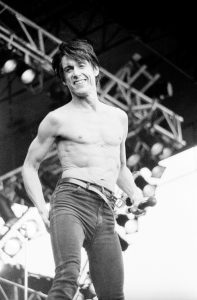
Originally from Detroit, Michigan, Iggy Pop is often referred to as the “Godfather of Punk” for the music he made with his group The Stooges as well as his wild performance style where he brought real danger, not the illusion of danger, into rock performance. He invented the stage dive where the performer jumps straight into the audience. When performances were especially rowdy and glass bottles were broken onstage, Pop rolled around in the broken glass then got back up, cut up and bloody, and continued singing. It is probably Iggy Pop, more than any other performer, that developed the style and approach most influential on Punk Rock. The Stooges’ music was similarly aggressive, featuring the distorted guitar work of Ron Asheton. The Stooges were initially together from 1967-1974, and reformed in 2003.
Iggy Pop was originally a drummer and had an interest in the blues musicians like Muddy Waters and John Lee Hooker. Pop’s interest in the blues had him going so far as to move to Chicago to learn from blues drummers. This period led to a realization that in order to be authentic he couldn’t study and copy blues, he had to come up with his own version of simple blues and be true to himself. “So that’s what I did. I appropriated a lot of their vocal forms and their turns of phrase-either heard or misheard or twisted from blues songs. So “I Wanna Be Your Dog” is probably my mishearing of “Baby Please Don’t Go” (McNiel pg. 38). Other artists that influenced Pop’s performance style were Jim Morrison of The Doors and Mick Jagger of the Rolling Stones. He was impressed with Morrison’s nonchalant attitude to appeasing his fans and in fact his confrontational approach to the audience and Jagger’s half-spoken way of singing. On Morrison and the Doors, “I loved the antagonism; I loved that he was pissing them off… and not only was Morrison pissing them off, but he mesmerizing them at the same time” (McNeil, pg. 40). This eventually led to the formation of the Stooges with brothers Ron and Scott Asheton, guitarist and drummer.
The Stooges music set the template for Punk Rock with the distorted fuzzy power chords, monotone vocals, and confrontational performances in songs such as “I Wanna Be Your Dog”. The lyrics below are essentially a love song from the singer to the admired, offering a slavish devotion. The form is verse-chorus form lyrically, but a closer listen reveals the verse and the chorus are very nearly the same and could be described as Repeated A sections when referring to the music.
In my room, I want you here
Now we’re gonna be face-to-face
And I’ll lay right down in my favorite place
Now I want to be your dog
Now I want to be your dog
Well, come on
And now I’m ready to close my mind
And now I’m ready to feel your hand
And lose my heart on the burning sands
And now I wanna be your dog
Now I want to be your dog
Well, come on
Listening Examples 17.1
Iggy Pop and the Stooges: In “I Wanna Be Your Dog” the use of the aggressive, throbbing pulse and the shouted, nearly monotone vocals (monotone is a single unvaried pitch) hints toward punk music. Here is the band live.
American Punk
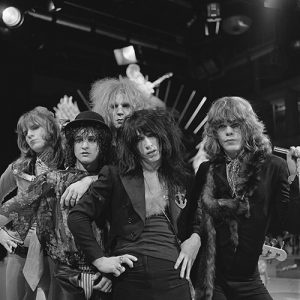
The New York Dolls were one of the first of these early groups to break into the mainstream. With an androgynous look, the Dolls were shocking to audiences in the early 1970s. Additionally, they adopted the confrontational approach of Iggy and the Stooges. “The audiences were pretty depraved,” says David Johansen, singer of the New York Dolls, “We couldn’t come out in three-piece suits and entertain that bunch. They wanted something more for their money. And we were very confrontational. We were very raw. We were really into confronting the audience: ‘HEY YOU STUPID BASTARDS, GET UP AND DANCE!’ We were not polite.” On the influence of the Dolls on punk rock and the simplicity of their music, Johansen adds “People who saw the Dolls said, ‘Hell, anybody can do this.’ I think what the Dolls did as far being an influence on punk was that we showed that anybody could do it.” (McNiel, pg. 128)
Many of the popular early punk groups in America originated in New York City and the NYC club CBGB’s was a starting place for many of these groups to perform, including the group Television. Television combined the simple punk sensibility of the Velvet Underground, melodic guitar lines, and psychedelic improvisations. Their bass player, Richard Hell, was innovative in his punk fashion through torn clothing and spiked hair. Unlike many punk groups, Television put an emphasis on quality musicianship in combination with raw instrumental timbres. Television was one of the first groups to play at CBGB’s, in early 1974.
Patti Smith (Born 1946) was a poet and writer who moved to New York to pursue poetry. She published a book of her own poetry called “Seventh Heaven” in 1972. Smith would perform live poetry readings and began to incorporate music by way of poetry readings blending with simple guitar accompaniment by guitarist Lenny Kaye who would go on to collaborate with Smith for years. Even her poetry readings had a sensibility anticipating punk rock. Author Victor Bockris says of a poetry reading in which Smith read an early version of the forgot, “Her sound combined the musical simplicity of the Velvet Underground with her own energetic vocals. The song “Horses” (Ch. 17 Listening Examples) begins with a spoken-word introduction reflecting Smith’s poetic background before delving into a simple 3-chord rock song. Vocally, Smith sings in a largely monotone fashion. The music is aggressive, driving, and distorted.
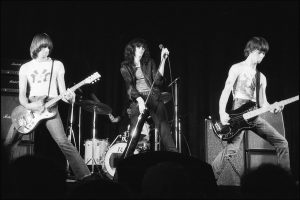
The Ramones formed in 1974 and had a large influence on the development of British punk through their performances in England. Growing up in the Forest Hills neighborhood in Queens, NYC, Tommy, Joey, Johnny and Dee Dee Ramone all lived in the same area and bonded over a mutual love for The Stooges and the New York Dolls. They put together a band, deciding on the name The Ramones and came up with monikers for themselves. They played a high energy punk in which songs rarely lasted more than 2 minutes. Most often the songs use no more than 3 or 4 simple “power chords” on the guitar, while the vocals were often simple melodies rather than a straight-forward monotone approach. “Blitzkreig Bop” fits all the parameters of punk with fast tempos, 3 chords, minimally melodic vocals, and overall a very short length.
Listening Examples 17.2
Velvet Underground: “Heroin”
New York Dolls:“Personality Crisis” live 1973
Patti Smith:
- “Horses”
- “Horses” live
- “Because the Night” co-written with Bruce Springsteen
The Ramones:
British Punk
Punk appealed to lower and middle class teenagers in Britain who grew up detesting the lifestyles and traditions of their parents. They felt they had no control over their lives and were destined to stay in poverty because of a class-ridden social system. The youth saw rock as being played by wealthy stars and weren’t interested. They were anti-fashion, wearing torn clothes with safety pins holding them together. Anarchy was enthusiastically supported by many British punk fans.
An important and diverse British punk group was the Clash. They were notable for exploring lyrical subjects of youth unemployment, racism, and police brutality. They often combined musical characteristics of punk with the hesitation beats and socially conscious lyrical approach of Jamaican reggae and ska. Singer Joe Strummer had a more melodic approach to his vocals, combining this melodic sensibility with a rough, unpolished vocal timbre, fitting to the aggressive tone of the music.
The Sex Pistols

The Sex Pistols became the biggest British Punk group, starting controversy everywhere they went. They used distorted guitars, monotone vocals, and their high energy performances were often associated with violence with the band even getting in fights with the audience occasionally! The music was fast, simple, and aggressive.The group was successful in a short time before breaking up in 1978, and then bassist Sid Vicious died of a drug overdose in 1979.
The Dead Kennedys
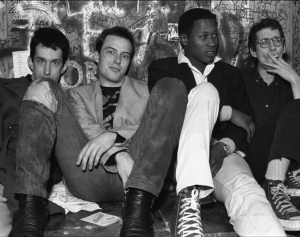
The Dead Kennedys formed in San Francisco in 1978, using the punk sound and monotone vocals criticizing the US government and other institutions with a sense of humor. The lead singer and lyrcist Jello Biafra took his name when he heard the government sent a shipment of Jell-O to the starving people in Biafra, Africa as “foreign aid”.
The song “Kill the Poor” (Ch. 17.3 Listening Examples) makes a darkly humorous statement of the fact that US politicians put money towards weapons research for things such as the neutron bomb (a theoretical weapon which could kill people and destroy organic matter but leave physical structures like roads and buildings intact), while money to aid America’s poor and mentally ill was refused.
Listening Examples 17.3
Clash: “I Fought the Law”, originally written by Sonny Curtis who played with Buddy Holly and the Crickets. The Clash reworked the song into an aggressive, punk, anti-authoritarian statement.
The Sex Pistols:“God Save the Queen” became commercially successful proving that the punk movement represented a large part of the youth. Like “Blitzkreig Bop”, the song uses 3 chords, is vocally monotone-based, and lyrically controversial, criticizing the Queen and England’s love for the monarchy.
The Dead Kennedy’s: “Kill the Poor”
New Wave
Since punk was such an aggressive style of music, it didn’t create a wide appeal to general population. The revitalized energy was appealing though, and many characteristics of it were integrated into a new style called New Wave. New Wave used the pulse-based rhythms of punk, monotone vocals, and emotional alienation of punk music, but also used a wider variety of instruments such as synthesizers, and generally had a clean and slick sound. Devo was a new wave group who created an image that took a humorous look on the de-humanization of modern society. Their robotic music and image conveyed this de-humanization. Other groups such as Blondie, the B52s and The Cars represent the New Wave style.
Talking Heads
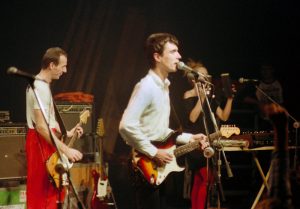
The Talking Heads were a New Wave band from New York City that initially used the energy and simplicity of punk music but would later incorporate a wide variety of styles and instruments into their sound. Led by singer/guitarist/songwriter David Byrne, the band was made up of guitarist and keyboardist Jerry Harrison, bassist Tina Weymouth, and drummer Chris Frantz. Their early style featured a simple, pounding rhythmic pulse and Byrne’s signature near- monotone singing style.
Elvis Costello

Elvis Costello (Born 1955) is an important English musician who became popular through new wave. He began playing a back to roots form of rock called “pub rock” and adopted a Buddy Holly-esque image, changed his name to Elvis, but represented an updated version of the traditional rock star. Costello’s music represented his neurotic image, often singing of insecurities in relationships, but also sang of political subjects.
He moved into the new wave sound with the album This Year’s Model (1978) which introduced his new backup band, the Attractions. His new wave style used some of the energy of punk while incorporating the clean slick sound of American new wave. Costello didn’t stick to new wave strictly though, and with the album Almost Blue (1981) he began exploring American country music.
Listening Examples 17.4
Devo:
- “Jocko Homo” live
- “Whip It” (1980), Devo’s biggest hit
Talking Heads:“Psycho Killer” features a Verse-Chorus form in which David Byrne sings monotone in the verse and melodically in the chorus. Here is the live version. Later albums such as Remain in Light saw the band incorporate funk, African rhythms, and new musicians as well. Horns, synthesizers, and new percussion were incorporated into the music with musicians such as Bernie Worrell (Parliament Funkadelic) and Adrian Belew (Frank Zappa, King Crimson) joining the group for periods.
Elvis Costello: “Radio Radio”
Ska and Reggae
The island nation of Jamaica was responsible for the emergence of two new genres of music known as Ska and Reggae. These styles were the result of the blending of popular American music of the 1940s and 1950s, particularly Rhythm and Blues, and the Jamaican folk music known as Mento. This music used an English dialect, but dialects could vary from song to song because many languages were spoken in Jamaica. Mento music used Cuban rumba rhythms at a slower tempo and other African-derived rhythms, played occasionally on European instruments, and more often on homemade instruments.
Ska developed out of the popularity of rhythm and blues in Jamaica with musicians adding characteristics of Mento to the rhythm and blues beats. The most characteristic element of ska is the accenting of a subdivision just after each beat (most often structured in 4-beat patterns), often called a hesitation beat. Ska also made use of horns the way rhythm and blues had.
Reggae formed out of rocksteady, a slowed down version of ska. Eventually this music became reggae. It featured more African-styled drumming, modern amplified instruments, less horns, more present and bright offbeat guitar chords, and socially conscious lyrics with the hesitation beat feel of ska.
Desmond Dekker

Desmond Dekker – (1941-2006) was a Jamaican musician who performed ska music as well as rocksteady and reggae. He was one of the first Jamaican musicians to become internationally popular. He knew Bob Marley when they were teenagers, and Marley recommended Dekker to a producer who helped him organize his backing group, the Aces. Much of his music glorified the “rude boy” culture. The “rude boys” were a young and rough criminal element in Jamaica.
The song “007 (Shanty Town)” (Ch. 17.5 Listening Examples) was a hit on the British pop charts where his music remained popular into the 1970s. Many of his songs were revived in the late 1970s “2-tone” music movement which combined ska, punk, and new wave styles. The song uses many characteristics of the ska style such as even beat subdivisions, stressed hesitation beats (1 & 2 & 3 & 4 &), and a relaxed feel.
Bob Marley and the Wailers
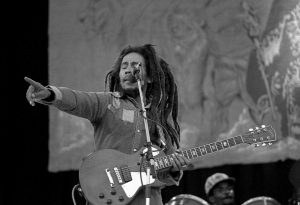
Bob Marley (1945-1981) Began recording as a member of vocal group The Wailers with Peter Tosh and Bunny Wailer in the mid 1960s. The three expanded their sound by learning instruments and forming a group which they led still called the Wailers. Their albums were successful in Jamaica, but when they signed to Island Records, a British run record company, that their music became known internationally.
When Eric Clapton covered the song “I Shot the Sheriff” it made the song internationally famous and turned many fans on to the infectious beat of reggae. Tosh and Wailer left in 1974 and Marley continued performing with his own group for the remainder of the 1970s. Marley’s music was socially conscious and he protested against corruption and the oppression of the poor.
The song “Stir it Up” by The Wailers is a prime example of reggae. It uses a blend of musical features common in reggae, including hesitation beats (primarily in the off beat guitar accompaniment), melodic bass lines (the bass plays a melody, an uncommon role for the bass in popular music), and standard song forms. Look at the lyrical excerpt below to discover the song form based on what you know.
Come on and stir it up, little darlin’, stir it up. O-oh!
Since I’ve got you on my mind (oh-oh-oh-oh) Oh-oh!
Now you are here (stir it, stir it, stir it together), I said
It’s so clear
To see what we could do, baby, (oh-oh-oh-oh)
Just me and you
Come on and stir it up, yeah! Little darlin’, stir it up! O-oh!
Then I blaze ya fire
Then I’ll satisfy your heart’s desire. (Oh-oh-oh-oh)
Said, I stir it together (stir it, stir it, stir it together)
Every minute
All you got to do, baby, (oh-oh-oh-oh)
Is keep it in, and
Little darlin’, stir it up! Wo-oh! Mm, now, now
Listening Examples 17.5
Desmond Dekker: “007”
Bob Marley explains rhythmic differences between Ska, Rocksteady, and Reggae. Here I demonstrate the Reggae hesitation beat.
Bob Marley and the Wailers:
- “Stir It Up”
- “Stir It Up” live
Influence of Reggae on Rock and the Ska Revival
Ska and reggae had an influence on other types of popular music, first with Eric Clapton’s cover of “I Shot the Sheriff”, and later influencing the sound of bands such as the Clash and the Police.
The Clash used reggae beats and bass lines as well as the political messages, combining those traits with punk characteristics.
The Police combined the punk style with elements of reggae such as the beats and melodic styles, but without the political messages. They became very successful with their blending of punk, reggae, and pop.
Former punk group The Specials began a Ska revival in England in the late 1970s. This new style merged the pulse and shouted vocals of punk and the hesitation beat of ska. They spoke out against racism and were a racially mixed group. They formed their own record company, 2-Tone Records. 2-Tone became the name for this ska revival.


